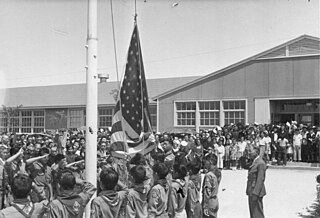
During the early years of World War II, Japanese Americans were forcibly relocated from their homes in the West Coast because military leaders and public opinion combined to fan unproven fears of sabotage. As the war progressed, many of the young Nisei, Japanese immigrants' children who were born with American citizenship, volunteered or were drafted to serve in the United States military. Japanese Americans served in all the branches of the United States Armed Forces, including the United States Merchant Marine. An estimated 33,000 Japanese Americans served in the U.S. military during World War II, of which 20,000 joined the Army. Approximately 800 were killed in action.
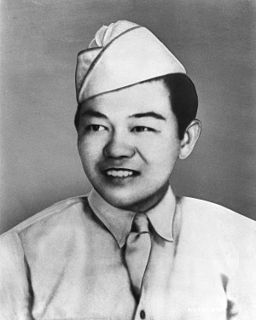
Sadao Munemori was a United States Army soldier and posthumous recipient of the Medal of Honor, after he sacrificed his life to save those of his fellow soldiers at Seravezza, Italy during World War II.

The 100th Infantry Battalion is the only infantry unit in the United States Army Reserve. In World War II, the then-primarily Nisei battalion was composed largely of former members of the Hawaii Army National Guard. The 100th saw heavy combat during World War II, starting in September 1943 and continuing after being attached as a battalion of the Nisei 442nd Regimental Combat Team in June 1944. The unit was unofficially nicknamed the Purple Heart Battalion, with the motto "Remember Pearl Harbor".
On February 19, 1942, President Franklin D. Roosevelt signed Executive Order 9066 relocating over 110,000 Japanese Americans from the West Coast into internment camps for the duration of the war. The personal rights, liberties, and freedoms of Japanese Americans were suspended by the United States government.

George Taro "Joe" Sakato was an American combat soldier of World War II who received the Medal of Honor, the nation's highest military award for valor.

Ted Takayuki Tanouye was a Japanese American soldier in the United States Army who posthumously received the United States military's highest decoration for bravery—the Medal of Honor—for his actions in World War II.

Kazuo Otani was a United States Army soldier and a recipient of the United States military's highest decoration—the Medal of Honor—for his actions in World War II.
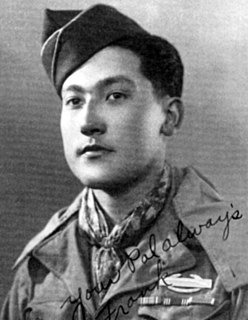
Frank H. Ono was a United States Army soldier and a recipient of the United States military's highest decoration—the Medal of Honor—for his actions in World War II.
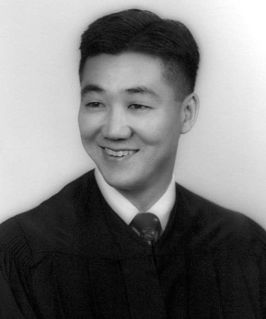
James K. Okubo was a United States Army soldier. He was a posthumous recipient of the Medal of Honor for his actions in World War II.

William Kenzo Nakamura was a United States Army soldier and a recipient of the United States military's highest decoration—the Medal of Honor—for his actions in World War II.

Kiyoshi K. Muranaga was a United States Army soldier and a recipient of the United States military's highest decoration—the Medal of Honor—for his actions in World War II.
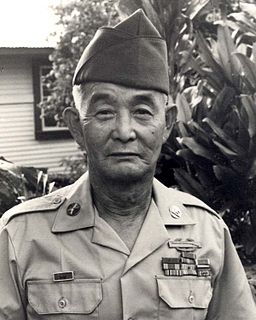
Kaoru Moto was a United States Army soldier. He was posthumously awarded the United States military's highest decoration—the Medal of Honor—for his actions in World War II.

The Military Intelligence Service was a World War II U.S. military unit consisting of two branches, the Japanese American unit and the German-Austrian unit based at Camp Ritchie, best known as the "Ritchie Boys". The unit described here was primarily composed of Nisei who were trained as linguists. Graduates of the MIS language school (MISLS) were attached to other military units to provide translation, interpretation, and interrogation services.
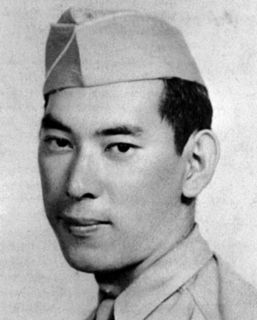
Robert Toshio Kuroda was a United States Army soldier. He was a recipient of the United States military's highest decoration—the Medal of Honor—for his actions in World War II.

Nisei is a Japanese language term used in countries in North America and South America to specify the ethnically Japanese children born in the new country to Japanese-born immigrants. The Nisei are considered the second generation, and the grandchildren of the Japanese-born immigrants are called Sansei, or third generation.

Japanese American history is the history of Japanese Americans or the history of ethnic Japanese in the United States. People from Japan began immigrating to the U.S. in significant numbers following the political, cultural, and social changes stemming from the 1868 Meiji Restoration. Large-scale Japanese immigration started with immigration to Hawaii during the first year of the Meiji period in 1868.

The Medal of Honor (MOH) is the United States government's highest and most prestigious military decoration that may be awarded to recognize American soldiers, sailors, marines, airmen, Space Force guardians, and coast guardsmen who have distinguished themselves by acts of valor. The medal is normally awarded by the President of the United States, but as it is presented "in the name of the United States Congress", it is often referred to (erroneously) as the "Congressional Medal of Honor".

The "Borinqueneers Congressional Gold Medal" is a Congressional Gold Medal awarded to Puerto Rico's 65th Infantry Regiment by President Barack Obama, at an official ceremony on June 10, 2014. On May 19, 2014, the United States House of Representatives passed the Bill, known as HR 1726 and three days later on May 22, 2014, the Senate approved Bill S. 1174. With the approval of both houses, the president signed the legislation which awarded the Congressional Gold Medal to the 65th Infantry, the first segregated Hispanic military unit, and the first unit of the Korean War, to receive such distinction.

















